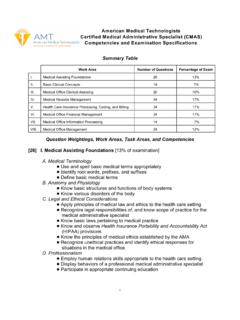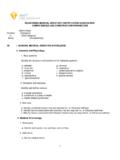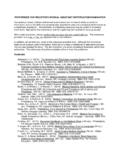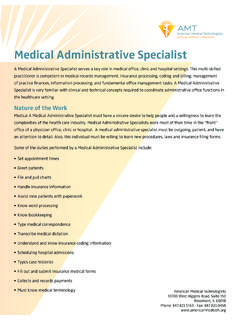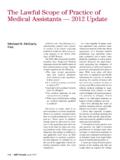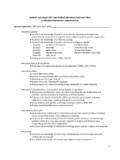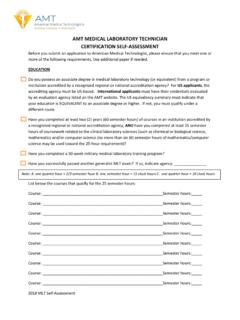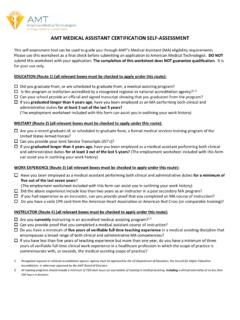Transcription of Registered Medical Assistant (RMA) Certification ...
1 2020 American Medical Technologists. All rights reserved. Page 1 of 15 Registered Medical Assistant (RMA) Certification Examination Competencies and Examination Specifications Summary Table Work Area Number of Questions Percentage of Exam I. Anatomy and Physiology 46 II. Administrative Medical Assisting 75 III. Clinical Medical Assisting 31 IV. Clinical Patient Interaction 58 Total 210 Question Weightings, Work Areas, Task Areas, and Competencies 46 I. ANATOMY AND PHYSIOLOGY ( of exam) A. Body Systems 1. Identify the structure and function of the following systems: a. skeletal g. nervous b. muscular h. respiratory c. endocrine i. cardiovascular/circulatory d. urinary j. integumentary e. reproductive k. special senses f. gastrointestinal 2. Disorders and diseases Identify and define various: a. disease processes b. conditions or states of health c.
2 Health-related syndromes 3. Wellness and nutrition a. Identify nutritional factors that are required for, or influence wellness b. Identify factors associated with exercise that are required for, or influence wellness # c. Identify factors associated with lifestyle choices that are required for, or influence wellness B. Medical Terminology 1. Word parts a. Identify word parts: root, prefixes, and suffixes 2020 American Medical Technologists. All rights reserved. Page 2 of 15 2. Definitions a. Define Medical terms 3. Common abbreviations and symbols a. Identify and understand utilization of Medical abbreviations and symbols 4. Spelling a. Spell Medical terms accurately 5. Terminology a. Define terminology associated with specialty examinations 75 II. ADMINISTRATIVE Medical ASSISTING ( of exam) A. Insurance 1. Terminology a. Identify and define terminology associated with various insurance types in the Medical office 2.
3 Plans a. Identify and understand the application of government, Medical , disability, and accident insurance plans b. Identify and appropriately apply plan policies and regulations for programs including: 1. HMO, PPO, EPO, indemnity, open, etc. 2. Short-term and long-term disability # 3. Family Medical Leave Act (FMLA) 4. Workers Compensation a. Complete first reports b. Complete follow-up reports # 5. Medicare (including Advance Beneficiary Notice (ABN)) 6. Medicaid 3. Claims a. Complete and file insurance claims # 1. File claims for paper and Electronic Data Interchange # 2. Understand and adhere to HIPAA Security and Uniformity Regulations b. Evaluate claims response # 1. Understand and evaluate explanation of benefits # 2. Evaluate claims rejection and utilize proper follow-up procedures # 4. Coding a. Identify HIPAA-mandated coding systems and references 1.
4 ICD-10-CM 2. CPT 3. HCPCS 2020 American Medical Technologists. All rights reserved. Page 3 of 15 b. Properly apply diagnosis and procedure codes to insurance claims 5. Insurance finance applications a. Identify and comply with contractual requirements of insurance plans # b. Process insurance payments and contractual write-off amounts c. Track unpaid claims # d. Generate aging reports # B. Financial Bookkeeping 1. Terminology a. Understand terminology associated with Medical financial bookkeeping 2. Patient billing a. Maintain and explain physician's fee schedules b. Collect and post payments # c. Manage patient ledgers and accounts # d. Understand and prepare Truth in Lending Statements e. Prepare and mail itemized statements # f. Understand and employ billing cycles 3. Collections a. Prepare aging reports and identify delinquent accounts b.
5 Understand application of the Fair Debt Collection Practices Act c. Understand and perform appropriate collection procedures # 4. Fundamental Medical office accounting procedures a. Employ appropriate accounting procedures # 1. Pegboard / double entry # 2. Computerized # b. Perform daily balancing procedures # c. Prepare monthly trial balance # d. Apply accounts receivable and payable principles 5. Banking procedures a. Understand and manage petty cash account b. Prepare and make bank deposits # c. Maintain checking accounts # d. Reconcile bank statements # e. Understand check processing procedures and requirements # 1. Non-sufficient finds (NSF) # 2. Endorsements # f. Process payables and practice obligations # g. Understand and maintain disbursement accounts # 6. Employee payroll a. Prepare employee payroll # 2020 American Medical Technologists.
6 All rights reserved. Page 4 of 15 1. Understand hourly and salary payroll procedures # 2. Understand and apply payroll withholding and deductions # b. Understand and maintain payroll records # 1. Prepare and maintain payroll tax deduction/withholding records # 2. Prepare employee tax forms # 3. Prepare quarterly tax forms and deposits # c. Understand terminology pertaining to payroll and payroll tax 7. Financial mathematics a. Understand and perform appropriate calculations related to patient and practice accounts C. Medical Receptionist / Secretarial / Clerical 1. Reception a. Employ appropriate communication skills when receiving and greeting patients b. Understand basic emergency triage in coordinating patient arrivals c. Screen visitors and salespersons arriving at the office # d. Obtain patient demographics and information e. Understand and maintain patient confidentiality during check-in procedures f.
7 Prepare patient record g. Assist patients into examination rooms 2. Scheduling a. Employ appointment scheduling system 1. Identify and employ various scheduling styles (wave, open, etc.) b. Employ proper procedures for cancellations and missed appointments c. Understand referral and authorization process d. Understand and manage patient recall system # e. Schedule non-office appointments (hospital admissions, diagnostic tests, surgeries) 3. Oral and written communication a. Employ appropriate telephone etiquette b. Perform appropriate telephone c. Instruct patients via telephone d. Inform patients of test results per physician instruction e. Receive, process, and document results received from outside provider f. Compose correspondence employing acceptable business format g. Employ effective written communication skills adhering to ethics and laws of confidentiality h.
8 Employ active listening skills 4. Records and chart management a. Manage patient Medical record system b. Record diagnostic test results in patient chart c. File patient and physician communication in chart d. File materials according to proper system 1. Chronological 2. Alphabetical 3. Problem-oriented Medical records (POMR) 4. Subject # 2020 American Medical Technologists. All rights reserved. Page 5 of 15 e. Protect, store, and retain Medical records according to proper conventions and HIPAA privacy regulations f. Prepare and release private health information as required, adhering to state and Federal guidelines g. Identify and employ proper documentation procedures adhering to standard charting guidelines 5. Transcription and dictation # a. Transcribe letter or notes from direct dictation # 6. Supplies and equipment management a. Maintain inventory of Medical / office supplies and equipment b.
9 Coordinate maintenance and repair of office equipment # c. Maintain equipment maintenance logs according to OSHA regulations 7. Computer applications a. Identify and understand hardware components # b. Identify and understand application of basic software and operating systems c. Recognize software application for patient record maintenance, bookkeeping, and patient accounting system # d. Employ procedures for integrity of information and compliance with HIPAA Security and Privacy regulations 1. Encryption 2. Firewall software and hardware # 3. Personnel passwords 4. Access restrictions # 5. Activity logs # 8. Office safety a. Maintain office sanitation and comfort b. Develop and maintain office safety manual c. Develop emergency procedures and policies d. Employ procedures in compliance with Occupational Safety and Health Administration (OSHA) guidelines and regulations 1.
10 Hazard communication 2. Engineering and Work Practice Controls 3. Employee training program # 4. Standard Precautions e. Maintain records of biohazardous waste and chemical disposal D. Medical Law and Ethics 1. Medical law Identify and understand the application of: a. consents and contracts used in Medical practice b. disclosure laws and regulations (including HIPAA Security and Privacy Acts, state and Federal laws) 2020 American Medical Technologists. All rights reserved. Page 6 of 15 c. laws, regulations, and acts pertaining to the practice of medicine d. scope of practice acts regarding Medical assisting e. Patient Bill of Rights legislation f. Advance Directives 2. Licensure, Certification , and registration a. Identify credentialing requirements of Medical professionals b. Understand the application of the Clinical Laboratory Improvement Amendments of 1988 (CLIA 88) 3.
